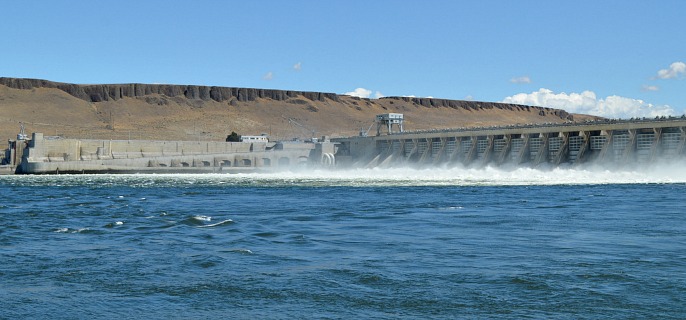
To the untrained eye, it’s a box of copper planks.
But these wands, called stator bars, are where the magic happens in hydroelectric generation.
Kathy Spillane says stators are the hidden key to transforming the muscle of the Columbia River into the low-cost, carbon-free electricity used across the Pacific Northwest. And Spillane – who has successfully led an $86 million federal project to replace 1,044 of the copper bars at McNary Dam – would certainly know.
“The stator windings are the invisible piece of the hydro plant, part of the mystery people don’t understand,” says Spillane, a project manager with the U.S. Army Corps of Engineers. “But they’re really the heart of the generator.”
Tim Roberts, the dam’s chief of maintenance, agrees: “It is like magic. It’s magnetic theory – you can’t see it; you just have to believe it. And that’s where it happens.”
McNary’s original stator windings had been producing electricity virtually 24/7 since the dam went into full service in 1957 near Umatilla, Ore. Its powerhouse, at mile 292 from the mouth of the Columbia River, produces 980 megawatts at full capacity – enough to support about 686,000 homes. That’s more than the households in the cities of Seattle and Portland combined.

PHOTO COURTESY OF BPA
That’s why the ratepayers of the Bonneville Power Administration are investing $86 million at McNary Dam to install new stator windings on 10 generators, helping secure its dependable value for the next half century. A nonprofit federal agency, BPA markets wholesale electricity from the region’s 31 federal dams, and in return funds the operations, maintenance and capital improvements related to power generation at the hydroelectric plants.
The Corps of Engineers, McNary Dam’s owner, and its partners are now in the home stretch of the project to replace the original Eisenhower-era windings with state-of-the-art components. Besides BPA, the project partners are contractor Andritz Hydro and the Corps’ own Hydroelectric Design Center in Portland.
The labor-intensive project is expected to wrap up this fall. During the painstaking installation process, the 1,044 bars must be bonded by hand in a high-temperature process called brazing, using a torch at more than 1,000 degrees.
“We had a steep learning curve on the project, but we improved every year,” Spillane said. “We’ve had some really great teamwork with BPA and HDC (the hydro design center). When we’ve hit challenges, we’ve done a lot of effective problem-solving. We’ve been tested over and over, and our team unity is very strong.”
McNary is known as the hydraulic bottleneck of the Federal Columbia River Power System, which makes its level of performance crucial to the overall system. It occupies a critical position just downstream of the confluence of the Snake and Columbia rivers, but due to its physical characteristics, McNary has less flow capacity than the combination of dams above and below it.
“The turbines only have the ability to pass a certain amount of water through them,” Roberts explained. “We, at the project, view water as fuel. And sometimes we have too much fuel.”
To have a revolving roster of two generators disassembled and out of service over the course of five years would pose a challenge at any FCRPS dam, but managing McNary’s array of vital and often competing objectives can be even more difficult. Beyond its main job of producing a certain amount of electricity to serve the Northwest’s demand hour to hour, the dam provides the voltage support to keep the regional transmission grid stable in the era of variable wind power. It also maintains calibrated water flows to support endangered fish. At times of peak demand, when every available generator is needed for such operational flexibility, subtracting units compounds an already difficult juggling act.
“When I saw the original schedule for the stator replacements, I said, ‘10 units in five years? Wow, that’s an aggressive schedule,’ ” Roberts said. “To get this done even close to five years is pretty impressive.”
The project is part of a sequence of capital investments in the FCRPS, which provides nearly a third of the electricity consumed in the Pacific Northwest. As part of their broader asset strategy, BPA and the Corps decided it would be cost-effective to invest in better stators, which will have the capacity to produce 18 percent more power from the same amount of water.
This improvement was possible with next-generation insulation, which provides more protection in a thinner epoxy material. Streamlined insulation makes more room for larger, more powerful copper stator bars nested in the same space.
Each copper bar contains the potential to generate a particular amount of electricity, BPA electrical engineer Jack Kolze explained: “The plant at McNary has 1,044 bars of copper. Each one produces about 67 kilowatts – enough power to run 45 hair dryers. Put all of them together and you would be able to operate 46,980 hair dryers at high heat at the same time.”
The current work sets the stage for the next major project: the likely replacement of the dam’s 14 aging hydroelectric turbines with more efficient models in the coming decade. The new stators contain about 35 percent more copper, which will lift the capacity of each generator to 100 megawatts from its historic 84.7 MW after turbine upgrades.
“This shows foresight for the future,” Roberts says. “McNary is a really robust plant. They built it to last. With this project, you’ve reset the asset, as far as windings, for another 50 years and you’ve also provided the potential for increased capacity. That’s a win-win.”









